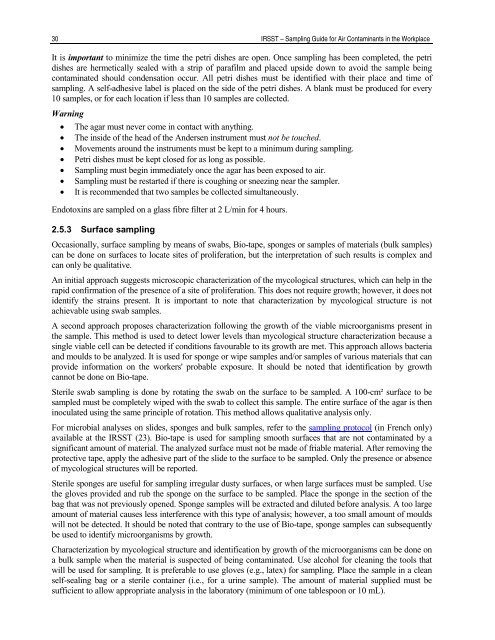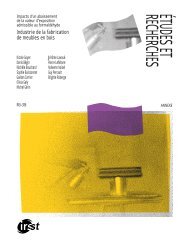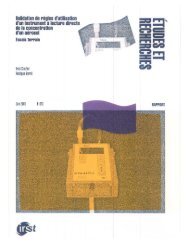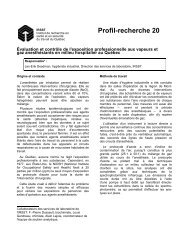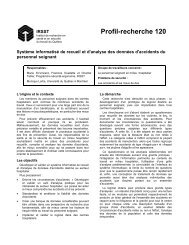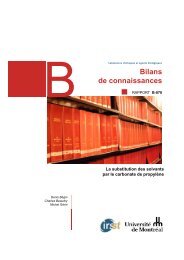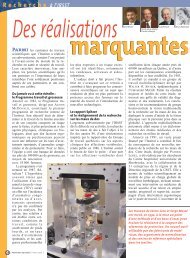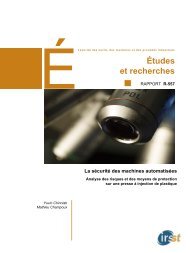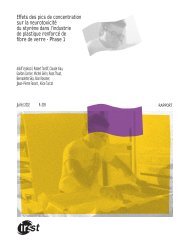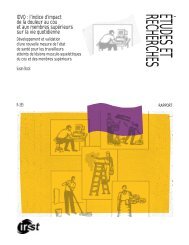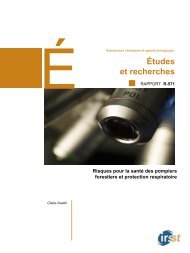Sampling Guide for Air Contaminants in the Workplace - Irsst
Sampling Guide for Air Contaminants in the Workplace - Irsst
Sampling Guide for Air Contaminants in the Workplace - Irsst
Create successful ePaper yourself
Turn your PDF publications into a flip-book with our unique Google optimized e-Paper software.
30 IRSST – <strong>Sampl<strong>in</strong>g</strong> <strong>Guide</strong> <strong>for</strong> <strong>Air</strong> <strong>Contam<strong>in</strong>ants</strong> <strong>in</strong> <strong>the</strong> <strong>Workplace</strong><br />
It is important to m<strong>in</strong>imize <strong>the</strong> time <strong>the</strong> petri dishes are open. Once sampl<strong>in</strong>g has been completed, <strong>the</strong> petri<br />
dishes are hermetically sealed with a strip of parafilm and placed upside down to avoid <strong>the</strong> sample be<strong>in</strong>g<br />
contam<strong>in</strong>ated should condensation occur. All petri dishes must be identified with <strong>the</strong>ir place and time of<br />
sampl<strong>in</strong>g. A self-adhesive label is placed on <strong>the</strong> side of <strong>the</strong> petri dishes. A blank must be produced <strong>for</strong> every<br />
10 samples, or <strong>for</strong> each location if less than 10 samples are collected.<br />
Warn<strong>in</strong>g<br />
• The agar must never come <strong>in</strong> contact with anyth<strong>in</strong>g.<br />
• The <strong>in</strong>side of <strong>the</strong> head of <strong>the</strong> Andersen <strong>in</strong>strument must not be touched.<br />
• Movements around <strong>the</strong> <strong>in</strong>struments must be kept to a m<strong>in</strong>imum dur<strong>in</strong>g sampl<strong>in</strong>g.<br />
• Petri dishes must be kept closed <strong>for</strong> as long as possible.<br />
• <strong>Sampl<strong>in</strong>g</strong> must beg<strong>in</strong> immediately once <strong>the</strong> agar has been exposed to air.<br />
• <strong>Sampl<strong>in</strong>g</strong> must be restarted if <strong>the</strong>re is cough<strong>in</strong>g or sneez<strong>in</strong>g near <strong>the</strong> sampler.<br />
• It is recommended that two samples be collected simultaneously.<br />
Endotox<strong>in</strong>s are sampled on a glass fibre filter at 2 L/m<strong>in</strong> <strong>for</strong> 4 hours.<br />
2.5.3 Surface sampl<strong>in</strong>g<br />
Occasionally, surface sampl<strong>in</strong>g by means of swabs, Bio-tape, sponges or samples of materials (bulk samples)<br />
can be done on surfaces to locate sites of proliferation, but <strong>the</strong> <strong>in</strong>terpretation of such results is complex and<br />
can only be qualitative.<br />
An <strong>in</strong>itial approach suggests microscopic characterization of <strong>the</strong> mycological structures, which can help <strong>in</strong> <strong>the</strong><br />
rapid confirmation of <strong>the</strong> presence of a site of proliferation. This does not require growth; however, it does not<br />
identify <strong>the</strong> stra<strong>in</strong>s present. It is important to note that characterization by mycological structure is not<br />
achievable us<strong>in</strong>g swab samples.<br />
A second approach proposes characterization follow<strong>in</strong>g <strong>the</strong> growth of <strong>the</strong> viable microorganisms present <strong>in</strong><br />
<strong>the</strong> sample. This method is used to detect lower levels than mycological structure characterization because a<br />
s<strong>in</strong>gle viable cell can be detected if conditions favourable to its growth are met. This approach allows bacteria<br />
and moulds to be analyzed. It is used <strong>for</strong> sponge or wipe samples and/or samples of various materials that can<br />
provide <strong>in</strong><strong>for</strong>mation on <strong>the</strong> workers' probable exposure. It should be noted that identification by growth<br />
cannot be done on Bio-tape.<br />
Sterile swab sampl<strong>in</strong>g is done by rotat<strong>in</strong>g <strong>the</strong> swab on <strong>the</strong> surface to be sampled. A 100-cm² surface to be<br />
sampled must be completely wiped with <strong>the</strong> swab to collect this sample. The entire surface of <strong>the</strong> agar is <strong>the</strong>n<br />
<strong>in</strong>oculated us<strong>in</strong>g <strong>the</strong> same pr<strong>in</strong>ciple of rotation. This method allows qualitative analysis only.<br />
For microbial analyses on slides, sponges and bulk samples, refer to <strong>the</strong> sampl<strong>in</strong>g protocol (<strong>in</strong> French only)<br />
available at <strong>the</strong> IRSST (23). Bio-tape is used <strong>for</strong> sampl<strong>in</strong>g smooth surfaces that are not contam<strong>in</strong>ated by a<br />
significant amount of material. The analyzed surface must not be made of friable material. After remov<strong>in</strong>g <strong>the</strong><br />
protective tape, apply <strong>the</strong> adhesive part of <strong>the</strong> slide to <strong>the</strong> surface to be sampled. Only <strong>the</strong> presence or absence<br />
of mycological structures will be reported.<br />
Sterile sponges are useful <strong>for</strong> sampl<strong>in</strong>g irregular dusty surfaces, or when large surfaces must be sampled. Use<br />
<strong>the</strong> gloves provided and rub <strong>the</strong> sponge on <strong>the</strong> surface to be sampled. Place <strong>the</strong> sponge <strong>in</strong> <strong>the</strong> section of <strong>the</strong><br />
bag that was not previously opened. Sponge samples will be extracted and diluted be<strong>for</strong>e analysis. A too large<br />
amount of material causes less <strong>in</strong>terference with this type of analysis; however, a too small amount of moulds<br />
will not be detected. It should be noted that contrary to <strong>the</strong> use of Bio-tape, sponge samples can subsequently<br />
be used to identify microorganisms by growth.<br />
Characterization by mycological structure and identification by growth of <strong>the</strong> microorganisms can be done on<br />
a bulk sample when <strong>the</strong> material is suspected of be<strong>in</strong>g contam<strong>in</strong>ated. Use alcohol <strong>for</strong> clean<strong>in</strong>g <strong>the</strong> tools that<br />
will be used <strong>for</strong> sampl<strong>in</strong>g. It is preferable to use gloves (e.g., latex) <strong>for</strong> sampl<strong>in</strong>g. Place <strong>the</strong> sample <strong>in</strong> a clean<br />
self-seal<strong>in</strong>g bag or a sterile conta<strong>in</strong>er (i.e., <strong>for</strong> a ur<strong>in</strong>e sample). The amount of material supplied must be<br />
sufficient to allow appropriate analysis <strong>in</strong> <strong>the</strong> laboratory (m<strong>in</strong>imum of one tablespoon or 10 mL).


